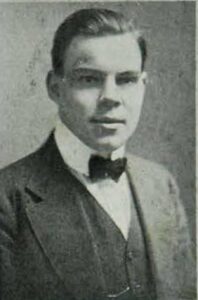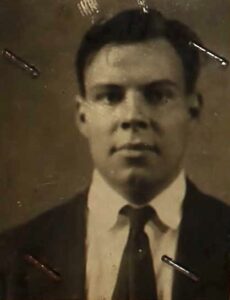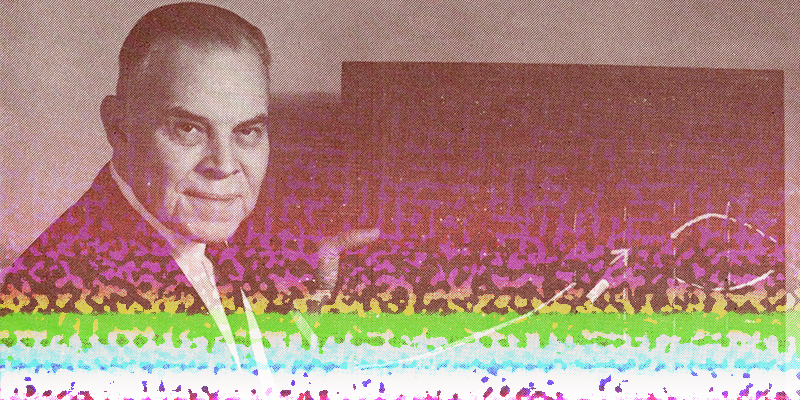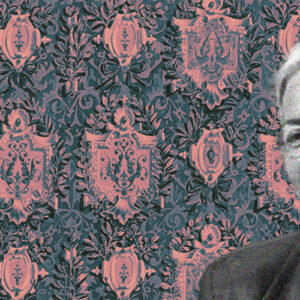During his lifetime the American theater director, drama teacher, attorney and amateur magician Henning Cunningham Nelms published but two detective novels under his pseudonym Hake Talbot: The Hangman’s Handyman (1942) and Rim of the Pit (1944). (Sadly his initial essay in the crime genre, written around 1940 and titled The Affair of the Half-Witness, never found a publisher and now seems unlikely ever to be recovered.) The Hangman’s Handyman was, like Rim of the Pit, well-reviewed at the time of its publication, yet the former novel faded soon enough from the memory even of mystery aficionados. However, Rim of the Pit clung tenaciously to fame by its gruesome horned fingernails as an inarguable classic of “impossible crime” mystery, i.e., a mystery where it appears that there is no rational explanation for how the dastardly deeds came to be committed (as in the case of a murder in a locked room). “In short,” impossible crime authority Douglas G. Greene has written, “the stories are constructed around events that seem impossible in an ordered universe.”
Over the years Rim of the Pit has been reprinted five times in the United States—in 1945 as the lead item in the pulp Thrilling Mystery Novel Magazine; in 1947 as a Dell mapback (with a map and floor plan on the back based on the author’s own sketches); in 1965 in Bantam’s World’s Great Novels of Detection series with an introduction by noted American mystery critic Anthony Boucher (author of his own locked room mysteries); in 1985 as an IPL Crime Classic with an introduction by the aforementioned Douglas G. Greene, biographer of locked room mystery master John Dickson Carr; and in 2009 by Ramble House, a dedicated connoisseur of the outré in mystery. Continuing the roughly two decade cycle, Rim of the Pit has now reappeared in 2023, nearly eighty years after its original publication, under the auspices of Mysterious Press.
Henning Cunningham Nelms was born on November 30, 1900 in Baltimore, Maryland, one of two children of native Virginian John Henning Nelms and his wife Mary Rosalie Cunningham, daughter of a New York commission merchant. John Henning Nelms was deemed a man of marked ability, in his twenties having been elected several times as mayor of his home town of Smithfield, located about twenty-five miles from historic Jamestown in the southeastern corner of Virginia, and served as a state attorney. A year after his son’s birth, John Henning Nelms abandoned his lucrative corporate law practice, through which he was earning an average of $10,000 a year (about $330,000 today), in order to study for the ministry. He enrolled at Bishop’s College, Lennoxville, Quebec (about forty miles from the US border) and three years later was ordained into the priesthood in 1904 by the Anglican Bishop of Quebec. (This experience likely served as inspiration for the French-Canadian background of Rim of the Pit.) After serving for four years as rector of St. Matthew’s Church, Philadelphia (during which time the number of communicants more than doubled), Nelms was called to take the helm at the affluent Church of the Ascension in Washington, D. C., housed in a striking Victorian Gothic structure. Here he served for over a dozen years until 1921, as his son Henning transitioned from adolescence to young adulthood.
 A precocious youth, Henning attended Washington, DC’s St. Alban’s School, one of the nation’s most prestigious prep schools for boys, and at the age of fifteen enrolled at the city’s George Washington University, making him the youngest student up to that time who had ever matriculated at that noted institution of learning. The “boy,” the GWU newspaper, The Hatchet, noted wryly at the time, in actuality stood six feet tall, weighed 170 pounds and was a member of the football squad. The school yearbook, The Cherry Tree, dubbed Henning (or “Cunning” as he was nicknamed) the “baby giant of the school” and avowed that he “would have made a splendid ad for some patented baby’s food.” Noting as well his passion for protracted intellectual debate, the yearbook drolly added that Henning’s “favorite pastime was mauling and rehashing some long, drawn-out question with Prof. Croissant in lieu of answering the question asked.”
A precocious youth, Henning attended Washington, DC’s St. Alban’s School, one of the nation’s most prestigious prep schools for boys, and at the age of fifteen enrolled at the city’s George Washington University, making him the youngest student up to that time who had ever matriculated at that noted institution of learning. The “boy,” the GWU newspaper, The Hatchet, noted wryly at the time, in actuality stood six feet tall, weighed 170 pounds and was a member of the football squad. The school yearbook, The Cherry Tree, dubbed Henning (or “Cunning” as he was nicknamed) the “baby giant of the school” and avowed that he “would have made a splendid ad for some patented baby’s food.” Noting as well his passion for protracted intellectual debate, the yearbook drolly added that Henning’s “favorite pastime was mauling and rehashing some long, drawn-out question with Prof. Croissant in lieu of answering the question asked.”
Following in his father’s early professional footsteps, Henning, after graduating with a BA from GWU in 1920, received a Bachelor of Laws degree from the University of Virginia two years later. Yet, also like his father, the young man had another vocational interest that came to the fore. Suggestive of this, Henning, while a student at UVA, put his strapping physique to good use in the school’s centennial pageant play, playing Gorman, “a workman of great stature.” After a stint as a sailor on a merchantman (again putting his physique to good use), Nelms settled down to practicing law in Washington, DC during the Twenties, yet he had a dashing gay side as well, like his more diminutive native Pennsylvanian contemporary John Dickson Carr. At the height of the Jazz Age in 1925, a year after the death of his father, Henning and his girlfriend Mary Kennedy—daughter of a prominent DC builder and realtor, an amateur horsewoman and a student at elite Bryn Mawr College in nearby Pennsylvania—were voted “best fox-trotting couple” at a prominent Virginia masquerade party, with his costume of Harlequin receiving additional commendation. (This costume choice, incidentally, recalls the 1923 Agatha Christie Hercule Poirot short story “The Affair at the Victory Ball,” Christie having been rather obsessed throughout her life with the mysterious harlequinade, as evinced in this story and her tales about a certain enigmatic individual named Harley Quin.)
Two years later saw the wedding of Henning and Mary, who had just graduated from Bryn Mawr. The couple soon departed Washington, D. C. for New Haven, Connecticut, where Henning studied theater at Yale University under noted playwriting professor George Pierce Baker, whose students included Eugene O’Neill and Thomas Wolfe. After being awarded a Master of Fine Arts degree from Yale in 1931, Henning—a genial, square-jawed pipe smoker—became director of the community theater at Harrisburg, Pennsylvania. His tenure lasted for six years, during which time he and Mary made a great hit with the local populace. Perhaps his most ambitious production during his time in Harrisburg was a staging of Russian author Maxim Gorky’s play The Lower Depths at the Jewish Community Center. Gamely Henning insisted to potential playgoers in the Harrisburg Telegraph that while the Russians had acquired a worldwide “reputation for morbid gloom” and Gorky was deemed “the most morbid and gloomy of the lot,” he contrarily did not find the play so: “[I]t is too vivid…and in a way more cheerful than ‘Grand Hotel’ for the people in ‘Grand Hotel’ were at the top and hopeless while the people in ‘The Lower Depths’ are at the bottom but very few of them have given up the struggle.”
 After departing Harrisburg in 1937, Henning later successively served for three years as director of the Little Theater at Houston, Texas; for two years as head of the drama department at Middlebury College at Middlebury, Vermont; and for a single year as director of the Springfield Civic Theater at Springfield, Ohio. In 1943 Henning and Mary with their young adopted son, Peter Gordon Hendrick, returned to Harrisburg for a nostalgic visit and later settled at a farm near Alexandria, Virginia, where Henning worked on his mystery masterpiece, Rim of the Pit, along with a burlesque melodrama, Only an Orphan Girl (1944), which for decades proved a popular piece for play productions in community theaters, colleges and high schools. (He seems to have missed service in the Second World War, owing perhaps to the severe burning to his left leg which he suffered in 1932 during a kerosene fire in his workshop.)
After departing Harrisburg in 1937, Henning later successively served for three years as director of the Little Theater at Houston, Texas; for two years as head of the drama department at Middlebury College at Middlebury, Vermont; and for a single year as director of the Springfield Civic Theater at Springfield, Ohio. In 1943 Henning and Mary with their young adopted son, Peter Gordon Hendrick, returned to Harrisburg for a nostalgic visit and later settled at a farm near Alexandria, Virginia, where Henning worked on his mystery masterpiece, Rim of the Pit, along with a burlesque melodrama, Only an Orphan Girl (1944), which for decades proved a popular piece for play productions in community theaters, colleges and high schools. (He seems to have missed service in the Second World War, owing perhaps to the severe burning to his left leg which he suffered in 1932 during a kerosene fire in his workshop.)
Over the course of his varied career in the theater, Henning authored several books about stage production and directed no fewer than seventy-two plays. Additionally, the author, an amateur magician, was active in the Society of American Magicians and the International Brotherhood of Magicians, organizations which served both professionals and amateurs. Later in his life Henning published Magic and Showmanship: A Handbook for Conjurors, a textbook on the philosophy, psychology and techniques behind the presentation of stage magic. Concerning this tome and its connection to Henning’s mystery writing, author Steven Steinbock, a crime writer and amateur magician himself, perceptively observed, in an article on Henning Nelms published in Mysteries Unlocked, a 2014 collection of essays in honor of Douglas G. Greene which I had the privilege of editing:
As Nelms observes in Magic and Showmanship: “The magic of drama is infinitely more powerful than the magic of trickery. It is as available to the conjurer as it is to the actor. The only difference is that actors take it for granted, whereas few conjurers are even aware that it exists.” Most of Magic and Showmanship is an elaboration of this point, a manual on using all resources to create the magic of drama. As a storyteller, Nelms applied these same principles to his fiction.
Henning “Cunning” Nelms, who even with his small published output of mystery fiction (just two novels and a pair short stories, one of the latter of which was never published during his lifetime) was one of the mystery genre’s greatest “showmen,” died from cardiac arrest at the age of eighty-five at his home in Arlington, Virginia on May 23, 1986, his wife Mary having predeceased him. Later in his life he rather resembled the elderly Boris Karloff, a fitting circumstance for an author of macabre mysteries. Before his demise Henning had the satisfaction of seeing Rim of the Pit brought back into print yet again, with due acknowledgement from Douglas G. Greene of its author’s place in the history of mystery fiction. “No tale provides more challenges to the reader than Rim of the Pit,” avowed Greene.
 Just half a dozen years earlier, a panel of eighteen authorities, including Greene himself, Frederic Dannay of Ellery Queen fame, Howard Haycraft, Jacques Barzun, Robert Adey, Bill Pronzini, Marvin Lachman and Jon L. Breen, were polled by the late, great impossible crime writer Edward D. Hoch for his fiction anthology All But Impossible! on the greatest impossible crime novels. This most distinguished group of crime writers and critics selected Rim of the Pit as the second best of all time, right after John Dickson Carr’s landmark locked room mystery The Three Coffins and ahead of Carr’s classics The Crooked Hinge and The Judas Window, not to mention those old impossible chestnuts Gaston Leroux’s The Mystery of the Yellow Room and Israel Zangwill’s The Big Bow Mystery. It was another single honor for Henning.
Just half a dozen years earlier, a panel of eighteen authorities, including Greene himself, Frederic Dannay of Ellery Queen fame, Howard Haycraft, Jacques Barzun, Robert Adey, Bill Pronzini, Marvin Lachman and Jon L. Breen, were polled by the late, great impossible crime writer Edward D. Hoch for his fiction anthology All But Impossible! on the greatest impossible crime novels. This most distinguished group of crime writers and critics selected Rim of the Pit as the second best of all time, right after John Dickson Carr’s landmark locked room mystery The Three Coffins and ahead of Carr’s classics The Crooked Hinge and The Judas Window, not to mention those old impossible chestnuts Gaston Leroux’s The Mystery of the Yellow Room and Israel Zangwill’s The Big Bow Mystery. It was another single honor for Henning.
In 1986, the year of Henning’s death, Bill Pronzini, in his book 1001 Midnights: The Aficionado’s Guide to Mystery and Detective Fiction, wrote admiringly of Rim of the Pit: “Even Carr at his most inventive could not have crammed more baffling and uncanny elements into one novel, convinced the reader that at least some of them must be of supernatural origin, and then proceeded to explain each rationally and plausibly.” Forty-two years earlier, when Rim of the Pit was first published, Anthony Boucher started this resounding chorus of high praise, avowing that the author “belongs among the very few [including John Dickson Carr, Clayton Rawson and Melville Davisson Post], who can build a horrifying and supernatural situation and then explain it without letdown. Whether you want eerie thrills or brilliant jiggery-pokery, this is your dish.” The master himself, John Dickson Carr, urged, in a review of the 1965 edition of Pit in his “Mystery-fancier Recommends” column in Harper’s Magazine: “Rim of the Pit is a beauty. Don’t argue with it; read it.”
****
As a crime writer Henning Nelms practiced what he preached as a dramatist and magician—he transmuted clever monkey tricks into compelling melodrama, like the Master himself, John Dickson Carr, and Henning’s fellow Virginian (well, West Virginian), Melville Davisson Post, to whose memory Henning dedicated Rim of the Pit. Both Handyman and Pit drip—bloodily, of course—with dramatic atmosphere, as reviewers at the time observed. Writing up The Hangman’s Handyman in the New York Times Book Review, Kay Irvin declared: This is a humdinger of a story by a new master of ingenuity. Hake Talbot seems headed for a place in the John Dickson Carr class.” And, indeed, the novel is a feast of the macabre, the mysterious and the highly puzzling with its cavalcade of such elements as these: a house party on a creepy isolated island off the North Carolina coast; a bizarre death seemingly resulting from the uttering of an ancient family curse; a suddenly putrefying corpse (in the manner of the Edgar Allan Poe story “The Facts in the Case of M. Valdemar,” a copy of which just happens to be on the spot); a murderous supernatural menace from the sea (“Undines….elementals….subhuman and…pretty horrible”); and, of course, slaying shenanigans in a locked room. Some people today avow that they prefer this superbly weird mystery tale to its successor Rim of the Pit, but to my mind Handyman is more of a warmup act, as it were, to Pit, the latter of which masterfully perfects all of the disparate elements in its predecessor.
In Rim of the Pit, Henning again employs the classic setting of the country house party, but the setting and atmospherics are stronger and the telling relentless. (There are no longueurs.) Both novels are cut to a similar pattern, including a series amateur detective–roguish, devil-may-care gambler Rogan Kincaid—a couple of attractive young women and assorted believers and non-believers in the paranormal phenomena that proceeds diabolically to envelop them. In Pit nine individuals have gathered at a house named Cabrioun in the Great North Woods of upper New England in order to conduct a séance to summon to the material plane the spirit of the late French Canadian businessman Grimaud Desanat, dead the last fourteen years after having gotten lost in the wilds of the Hudson Bay country (“Hell’s icebox”) during an ill-starred winter hunting trip. (Rogan Kincaid is literally along at Cabrioun for the ride.) But the séance, conducted by Grimaud’s mediumistic ex-wife (since unhappily remarried), goes horrifically wrong, seeming to set loose among the terrified party the malign spirit of the dead Grimaud, seeking to exact some grim and awful vengeance though the agency of demonic possession. Also on the scene is a mixed blood French-Canadian/Algonquian hunting guide who speaks fearfully (and phonetically) of the mythological evil spirits known as windigos/wendigos. Before long you too may end up believing that some insatiable foul flying fiend lately emerged from the pit is responsible for the bloody carnage at Cabrioun!
Writing about his adored literary idol Melville Davisson Post (of whom Steven Steinbock has observed “Post’s stories exhibit a metaphysical depth in which rationality is superimposed on theology without negating or eclipsing it. In this sense Post was seen as America’s answer to G. K. Chesterton.”), Hake Talbot observed:
He was not content to make the reader wonder about “who.” He also raised the questions about “how,” “why,” and “what.” In his best stories, he even succeeded in raising doubts about “whether;” the situations were so fantastic that a rational well-motivated explanation seems impossible. Nevertheless, Post always supplies it – sometimes even maintaining the suspense until what is literally the last word. . . . In my own writing, I have tried to emulate him. . . . I have tried to write stories in which the interest is not only in “who” but also in “why,” “how,” and “what.” I even hope that, occasionally, I may have led you to wonder about the “whether.”
In the discussions about rationality and the supernatural one finds in both The Hangman’s Handyman and Rim of the Pit, one gets a sense of precocious young “Cunning” Nelms around a century ago gleefully challenging his professors’ dogma during his college days at George Washington University and the University of Virginia, just as he likely did with his own minster father. (Indeed, Professor Ambler, one of the house party guests in Rim of the Pit, holds a position at Henning’s alma mater UVA.) The cunning “Hake Talbot” may well have you believing in the supernatural too, dear reader, only to pull the rug out from under your feet at the last moment with the dexterity of a master showman. Or does he? Read it and see! But first make sure to weave a circle round you thrice, for Henning Nelms on horrors and deceptions hath fed; and drunk the wine of impossibility.

















